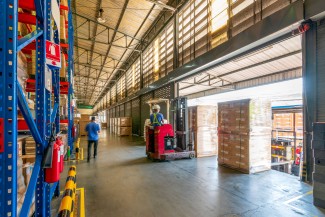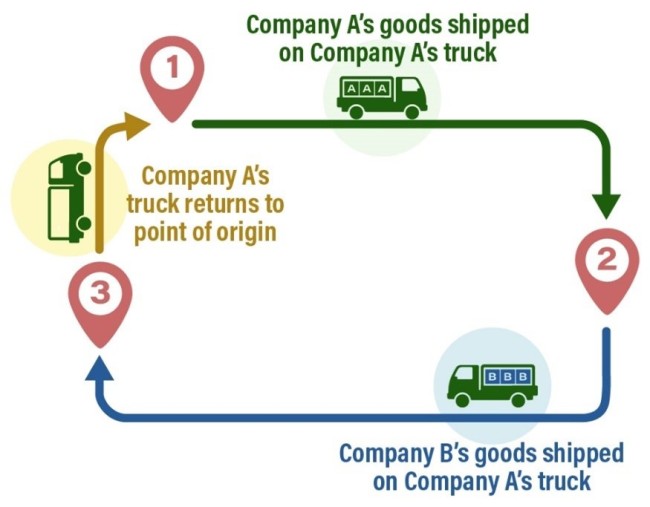Reducing truck miles traveled is critical to decarbonizing the freight sector. Technology can help achieve this by efficiently consolidating shipments and assigning shipments to otherwise empty truck trips.
According to the Environmental Protection Agency, medium- and heavy-duty trucks accounted for 23% of carbon emissions from the U.S. transportation sector, or 6.5% of all U.S. emissions, in 2021. Though emissions from these vehicles dropped in 2020, they grew to surpass 2019 levels in 2021 and have increased by 78% since 1990. Therefore, reducing emissions from the freight sector is a critical component of the nation’s transportation decarbonization strategy.
Truck electrification will be necessary to achieve the goal of an 80 to 100% reduction in transportation emissions by 2050, but electrifying every truck mile traveled will involve logistical and financial challenges that can be mitigated by reducing the total number of truck miles traveled every day. Reducing truck miles traveled, including electric truck miles, would also lower demand on the power grid.
Some truck trips are wasted or underutilized
Strategies to reduce truck miles traveled include reducing empty miles and increasing load factor. Empty miles occur when a truck is traveling empty, which happens when the truck is returning from a drop-off (known as an empty backhaul) or moving between a drop-off and a pick-up.
Even when trucks are not traveling empty, they are often not carrying cargo at full capacity. On average, the miles driven not empty have an average load factor of 57%, meaning 57% of the truck’s total capacity is taken up by cargo. This inefficiency leads to wasted energy and excess carbon emissions, but technology can help reduce empty miles and increase load factor. Usage of this technology is the subject of a new topic brief released by ACEEE today.
Digital freight networks can reduce emissions by optimizing freight movement
Digital freight networks (DFNs) are technologies that pool data to match shipments to trucks in a way that can improve freight efficiency. This can involve assigning shipments to trucks that are closer to the pick-up point, assigning shipments to fill empty backhauls, and combining shipments from different shippers with similar origin/destination pairs into one truck.
For example, one national retailer has a dedicated truck fleet that often travels empty when returning from a drop-off. The retailer partnered with a freight technology platform to identify other shippers that need to transport cargo and place their goods on the retailer’s trucks, filling an otherwise empty backhaul with cargo. This reduces emissions by allocating shipments to truck trips that take place anyway, thereby avoiding additional trips.
Companies that typically use their own truck fleets can reduce their empty miles by working through DFNs to identify loads from other companies to transport on their return trips.
Another example of how DFNs can improve freight efficiency is illustrated by the company Flock Freight. This freight technology firm matches shipments from different companies in a way that increases the fullness of trucks while creating the most direct route.
When shippers issue tenders, or requests for quotes, into Flock Freight’s platform, the technology calculates pricing estimates based on the probability that the shipments can be pooled. When tenders are accepted, the network creates a shipment plan for a single truck that enables pooling when possible.
Similar to carpooling, less-than-truckload (LTL) shipping reduces emissions by adding several shipments into one vehicle. However, Flock Freight estimates that its technology reduces emissions by up to 15% compared to LTL shipping thanks to more direct routing that avoids stopping at terminals, reducing the total miles traveled.
The federal government can help generate more data on DFNs
More research to understand the impact of DFNs on freight energy consumption and emissions would support informed policymaking around freight decarbonization. To advance this research, the Federal Highway Administration should, as part of its next review of its rule on greenhouse gas emissions targets, require states to set transportation emissions targets in line with national climate goals, reduce federal funding for bodies that repeatedly miss targets, and require targets specific to the freight industry. This would incentivize companies to gather data on, and adopt, freight efficiency measures and supportive technologies like DFNs.
Additionally, the Department of Transportation should strengthen the impact of its freight data exchange by increasing the types of data that participants can share, including data on origin-destination pairs, average load factor for freight carriers, and emissions reductions tied to specific efficiency improvements, including those achieved through DFN adoption.



